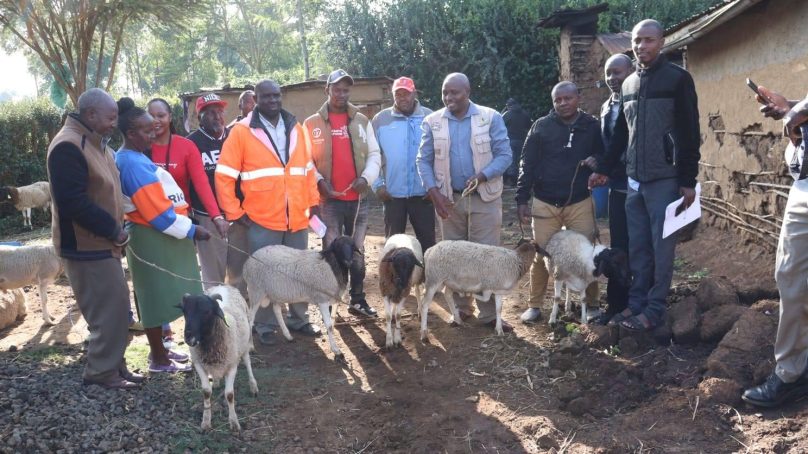
Dorper sheep rearing is gaining traction in Nakuru due to the breed’s hardiness, rapid growth and good meat quality.
Adoption of dorper sheep rearing in Nakuru coincides with the growing market in the Saudi Arabia and the broader Middle East, which is increasingly looking to East Africa for meat supply.
Originally from South Africa, Dorpers have adapted well to Kenya’s climate, especially in arid and semi-arid regions in the expansive Rift Valley and drylands in eastern, coastal and northern Kenya.
Their ability to thrive on minimal feed, coupled with their fast maturity and high lambing frequency, makes them a profitable choice for commercial sheep farming.
The county government of Nakuru has chipped in to bridge the gap between growing demand for Dorper sheep parent stock and through its livestock breeds improvement programme is distributing Dorper rams to enhance sheep breeds and productivity in the region.
As he hands over 65 Dorper rams to 10 farmer groups from Elmentaita Ward in Gilgil Subcounty, Livestock, Fisheries and Veterinary Services Chief Officer Michael Cheruiyot notes that the breed also has a very good feed conversion efficiency and are not selective grazers, hence will flourish even on relatively poor-quality feeds.
“Some farmers in what are called veld management systems put Dorper at the tail end of the feeding hierarchy for consumption of feeds not utilised or rejected by other livestock. This saves feed wastage,” he points out.
Previously, he notes most farmers in the devolved unit had been relying on recycled breeding rams, which had led to the production of undersize sheep, hence fetching a low income from their flock.
“Dorper sheep reach market weight quickly, offering faster returns on investment. They are fast growers and will attain 40 kilogrammes in just four months; making it very economical to produce. Research has put its daily weight gain at around 90 grammes. Add good nutrition into your plan and this can be increased and market weight attained even faster,” explains Cheruiyot.
He is optimistic that through the livestock breeds improvement programme launched by Governor Susan Kihika, the initiative will go a long way in not only improving sheep production but also weeding out the current breeds that have been affected by inbreeding.
The chief officer says the change to dorper sheep is good for farmers since they are relatively low-maintenance animals and they have good resistance to diseases and parasites, hence reducing the need for extensive care.
He notes that their other advantage was strong foraging abilities, which allows them to graze on a variety of vegetation, making them well-suited for extensive grazing systems.
The veterinarian says that, by rearing dorper sheep, local farmers can tap into the high demand of their potentially upper market prices for their products, adding that they can be effectively crossbred with other breeds to improve specific traits such as wool quality or disease resistance.
Overall, Cheruiyot says their flexibility allows farmers to adapt their flocks to specific production goals and market requirements and that makes them extremely popular.
Additionally, he says the dorper sheep are known for their adaptability to various climates and environments, since they can tolerate both hot and cold weather conditions, making them suitable for Nakuru’s diverse climate.
Rams reach sexual maturity at an early age and rams have been observed to be ready for mating by five months.
Cheruiyot points out that dorper are good at reproduction too and have a lambing interval of eight months. This means under good care; a farmer will be getting three lambs from his sheep every two years or two lambs annually.
“This is made possible by the fact that the dorper breed has a long breeding season that is not seasonally limited and the high fertility of ewes (female sheep). You just have to ensure there is always a ram within the herd to sniff for those on heat,” the chief officer explains.
While noting that dorpers are relatively resistant to diseases and parasites compared to some traditional breeds, Cheruiyot advises farmers to prioritise rams with good genetics and health records to improve the herd.
To avoid inbreeding, ram rotation is recommended, involving exchanging rams or purchasing them from different farms. Adequate feeding is essential for dorper sheep, especially during the breeding period. Regular vaccination, deworming, and monitoring for diseases are crucial.
Agriculture Chief Officer Newton Mwaura indicates that dorper sheep farming, especially the use of dorper rams, presents a promising opportunity for farmers in Kenya seeking a profitable and resilient livestock venture.
According to Mwaura the sheep requires very minimal labour in the field as all it does is to graze. It has less wool and therefore no need to shear (mulesing and crutching) to control fly strike or ease mating.
The dorper sheep is a cross-breed between the black headed Persian sheep (an African breed) and the Dorset horn (a British breed) that was developed in South Africa between 1945 and 1950. The name ‘dorper’ is a coupling of the first syllables of the parent breeds Dorset and Persian.
It is a very successful and adaptable breed that has been exported to many countries including Australia. It was introduced into Kenya about 50 years ago. There are two types: the dorper with a black head, neck and legs, and the ‘white dorper’ with a white head.
Mwaura highlighted that the dorper sheep adaptability has enabled some farmers to import some from South Africa, specifically for breeding superior quality and the breeders are sold as high as Ksh35,000-40,000 per sheep.
The chief officer revealed that their other benefit was high fertility, and they are known as prolific breeders that often produce twins or triplets, which can lead to fast increase of flock sizes and higher productivity for farmers.
He said the dorper sheep are primarily raised for their high-quality meat, which is tender, flavourful and well-marbled that makes it much sought-after by consumers, hence, leading to higher prices and profitability for farmers.
According to a farmer, Joseph Njoroge, the sheep performs well in semi-arid areas. They have a high lambing percentage and can breed every eight months.
“They lamb easily and are excellent mothers. They are also disease resistant and not susceptible to fly strike. Lambs gain weight quickly, mature early and may be mated at around 9 months,” explains Njoroge.
He adds “dorper sheep is also known to respond very well to good care and management. To improve profitability of any sheep breed you need to improve husbandry: good feeding, housing, disease and parasite control and vaccinations,”
Dorper sheep are, however, susceptible to gastro-intestinal nematodes (Haemonchus contortus).
- A Tell Media / KNA report / Bay Anne Mwale








